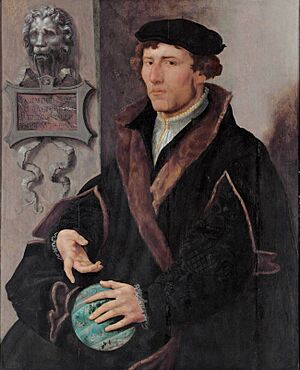Gemma Frisius facts for kids

Gemma Frisius (born Jemme Reinerszoon; December 9, 1508 – May 25, 1555) was a very talented Dutch person. He was a doctor, a mathematician, and a mapmaker. He also worked as a philosopher and created scientific tools.
Frisius made important globes and made better mathematical instruments. He found new ways to use applied mathematics for surveying land and for navigation (finding your way). An astronomical instrument called "Gemma's rings" is named after him.
Many people see Frisius as one of the founders of the Dutch school of mapmaking. He helped start a "golden age" for mapmaking in the Netherlands, which lasted from about the 1570s to the 1670s. He worked with famous mapmakers like Gerardus Mercator and Abraham Ortelius.
Contents
Life Story of Gemma Frisius
Frisius was born in Dokkum, Friesland (which is now part of the Netherlands). His parents were poor and died when he was young. He later moved to Groningen.
Education and Career
In 1525, Frisius began studying at the University of Leuven in Belgium. He earned his medical degree in 1536. He stayed at the University of Leuven for the rest of his life. There, he taught medicine, mathematics, astronomy, and geography. His oldest son, Cornelius Gemma, later edited some of his father's works.
One of his important teachers at Leuven was Franciscus Monachus. Around 1527, Monachus made a famous globe with the help of a goldsmith named Gaspard van der Heyden. Frisius then set up his own workshop to make globes and mathematical tools. He worked with Monachus and Van der Heyden.
These tools were known for being very good and accurate. Even famous astronomers like Tycho Brahe praised them. His land globe from 1536 and his sky globe from 1537 were especially famous. On the first globe, Frisius was listed as the creator. Gerardus Mercator, who was a student of Frisius at the time, helped with the engraving. On the second globe, Mercator was listed as a co-creator.
How He Used Triangulation
In 1533, Frisius was the first to explain a method called triangulation. This method is still used today in surveying to measure land.
Here is how it works:
- First, you set up a straight line between two known points, like two cities (for example, Brussels and Antwerp).
- Then, from each end of this baseline, you use a compass to find the direction of other cities (like Middelburg or Ghent).
- Where the two directions from the baseline cross, that's the location of the other city.
Frisius's drawing of this idea became very well known across Europe. Even though you couldn't actually see Middelburg from Brussels or Antwerp, his idea was very important.
Finding Longitude with Clocks
About 20 years later, around 1553, Frisius was the first to explain how a very accurate clock could help sailors find their longitude. Longitude tells you how far east or west you are on Earth.
At the time, many people didn't think this would work. A mathematician named Jean-Baptiste Morin even said it was "folly for man to try." It took another 200 years before John Harrison finally built a clock that was accurate enough for this purpose.
Instruments and Students
Frisius either created or made better many scientific tools. These included the cross-staff, the astrolabe, and the astronomical rings (also known as "Gemma's rings").
Many famous people were his students, including:
- Gerardus Mercator (who became his partner)
- Johannes Stadius
- John Dee
- Andreas Vesalius
- Rembert Dodoens
Later Life and Legacy
Gemma Frisius passed away in Leuven when he was 46 years old. His son, Cornelius Gemma, wrote that his father suffered from kidney stones for at least seven years.
Today, a crater on the Moon is named after him. Also, Gualterus Arsenius, a famous maker of scientific tools in the 1500s, was his nephew.
Works by Gemma Frisius
- Cosmographia (1529) von Petrus Apianus, with notes by Gemma Frisius
- De principiis astronomiae et cosmographiae (1530)
- De usu globi (1530)
- Libellus de locorum describendorum ratione (1533)
- Arithmeticae practicae methodus facilis (Antwerp, 1540)
- De annuli astronomici usu (1540)
- De radio astronomico et geometrico (1545)
- De astrolabio catholico (1556)
Images for kids
Honors
Frisius Point in the South Shetland Islands in Antarctica is named after Gemma Frisius.
See also
 In Spanish: Regnier Gemma Frisius para niños
In Spanish: Regnier Gemma Frisius para niños
- Triangulation by Gemma Frisius







